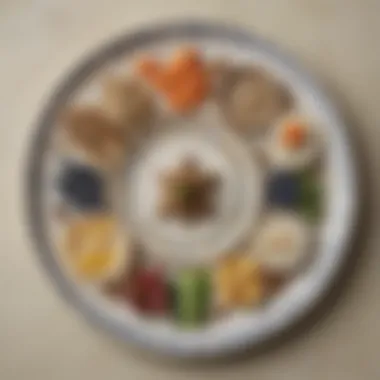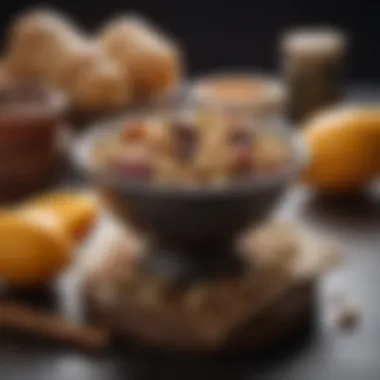Exploring the Symbolism of the Seder Meal in Depth


Intro
The Seder meal is not simply a gathering for food. It is a ritual steeped in symbolism and history that reflects the enduring values of freedom, community, and identity within Jewish culture. Each component on the Seder plate tells a story, a narrative that connects generations and brings to life the struggles and aspirations of the Jewish people. Analyzing the symbolism of the Seder meal allows us to uncover layers of meaning that resonate with both historical contexts and contemporary values.
This article intends to dissect the Seder meal's elements, exploring how they symbolize liberation and highlight the journey from slavery to freedom, as well as how these symbols continue to adapt and remain relevant today.
Understanding the Seder is also about recognizing personal interpretations. The Seder meal allows individuals and families to express their faith, culture, and experiences. The symbolism embedded within the elements of the meal serves as a vehicle for personal connection, thus fostering a sense of belonging in every participant, from novices to scholars.
By delving into the multifaceted meanings of each tradition, readers will gain insight into the connection between religion, culture, and identity that defines the Seder meal.
Preamble to the Seder Meal
The Seder meal marks a significant event in the Jewish calendar, observed during the Passover holiday. This meal is more than just a feast; it is a deeply symbolic ritual that encapsulates centuries of history, tradition, and faith. Understanding the Seder meal provides insights not only into Jewish culture but also into human resilience, memory, and the ongoing quest for freedom.
Historical Background
The Seder meal traces its roots back to the Exodus from Egypt, around 1300 BCE. During this pivotal event, the Israelites escaped slavery and embarked on their journey to freedom. The rituals and symbols we see today have evolved over time, informed by various historical experiences, from the Babylonian Exile to the Roman persecution. Originally, these customs were oral traditions. They were later codified into religious texts, most notably the Haggadah, which serves as a guide for the Seder.
In Jewish tradition, the Seder is rich with structure and symbolism. The use of specific foods is not arbitrary; each component has its own backstory and significance. Matters of memory play a crucial role in this meal, evoking the historical plight of the Jewish people and the importance of liberation.
Significance in Jewish Culture
The Seder meal serves as a vessel for cultural identity and community bonding. It allows families to come together, share stories, and pass down traditions. For many Jews, engaging in the Seder is a way to connect with their ancestors and nurture their spiritual heritage. The gathering reinforces a collective memory that speaks to the struggles and triumphs of the Jewish people over generations.
The rituals of the Seder address themes that resonate beyond the Jewish experience. These include questions of suffering, dignity, and hope. The Seder meal thus becomes a platform for discussing broader themes related to freedom and oppression. It invites contemplation on how current societal issues link back to past experiences.
"The Seder meal is not just a reflection on history; it is a reaffirmation of identity and a commitment to future generations who will continue this journey."
The Structure of the Seder
Understanding the structure of the Seder meal is crucial for appreciating its depth and significance. The Seder is not just a meal, but a carefully orchestrated ritual that encompasses various elements designed to engage participants in the story of the Exodus. This structure allows families and communities to connect with their history and tradition in a meaningful way. It highlights how each component plays a distinctive role in conveying the themes of freedom, identity, and memory.
Order and Rituals
The Seder follows a specific order, called seder, which means "order" in Hebrew. This order is essential, as each step builds on the last, creating a narrative flow that helps participants understand and reflect on the Jewish people's journey from slavery to freedom.


Key elements in this order include:
- Kadesh: The blessing over the first cup of wine. This marks the beginning of the Seder and signifies sanctification.
- Urchatz: The ritual washing of hands, which prepares participants for the food ahead while highlighting themes of purity.
- Karpas: The dipping of a vegetable in saltwater, representing the tears shed during slavery.
- Maggid: The centerpiece of the Seder, where the story of the Exodus is recounted. This section encourages discussion and questions, engaging all present.
- Motzi Matzah: The blessing over the matzah, bringing attention to its significance as the bread of affliction.
- Maror: The bitter herb, which evokes the harshness of slavery.
- Shulchan Orech: The festive meal, which allows for a moment of enjoyment and togetherness.
- Tzafun: The eating of the afikomen, a piece of matzah hidden earlier, symbolizing the hope for redemption.
- Barech: The Grace after meals, marking gratitude for food and freedom.
- Hallel: A recitation of praises, reflecting joy and thankfulness.
Each of these rituals enhances the commemorative aspect of the Seder while ensuring that participants do not simply eat a meal; they engage in a profound dialogue about their roots and past.
The Role of the Haggadah
The Haggadah serves as the guiding text for the Seder, detailing the rituals and customs involved. It frames the Seder experience, providing a script that facilitates the telling of the Exodus story.
This document is not merely a guide; it is a vessel of tradition and interpretation. Its contents often include:
- Narrative: A retelling of the Exodus story, bringing to light the struggles and victories of the Jewish people.
- Questions: Encouraging participants to engage, reflect, and articulate their understanding of freedom and oppression.
- Prayers and Blessings: Establishing an atmosphere of reverence and gratitude.
- Commentary: Offering various interpretations and insights that span generations, each version of the Haggadah may reflect unique cultural adaptations.
Through the Haggadah, the Seder meal transforms into an intergenerational dialogue, where the past meets the present. This allows participants to find personal relevance in age-old traditions, enriching their experience during the Seder.
Components of the Seder Plate
The Seder plate is a central element of the Passover Seder meal. Each component serves a specific purpose and carries rich symbolism. Understanding these components helps deepen the appreciation of the rituals and the freedom narrative celebrated during Passover. The following sections will explore each item on the Seder plate in detail, discussing its significance and role in the ceremony.
Maror: The Bitter Herbs
Maror represents the bitterness of slavery experienced by the Israelites in Egypt. Commonly made from horseradish, this component is intended to evoke the pain and suffering of the past. Eating maror during the Seder serves as a potent reminder of the struggles endured by previous generations. The intensity of the horseradish is symbolic as well; it reflects the harshness of oppression. This poignant element creates a moment of reflection, encouraging all participants to remember the weight of history.
Charoset: The Sweet Mixture
Contrasting with the maror, charoset symbolizes the mortar the Israelites used while enslaved. This mixture typically consists of apples, nuts, wine, and spices, creating a sweet blend. As attendees enjoy charoset, they can consider the duality of suffering and sweetness in life. This component reminds participants that even in difficult times, there can be moments of joy and comfort. The sweet taste, combining with the bitterness of maror, embodies the hope for liberation and a better future.
Karpas: The Vegetable
Karpas is usually a green vegetable, such as parsley, signifying renewal and spring. It is dipped into saltwater, representing the tears shed during bondage. This action invites participants to reflect on the cycle of life and the promise of new beginnings. The use of a vegetable as a symbol also connects to agricultural themes, emphasizing the importance of growth. Karpas invites each person at the table to partake in both the joyful and sorrowful aspects of their history.
Z'roa: The Shank Bone
Z'roa is typically a roasted shank bone, symbolizing the Passover sacrifice made during ancient times. This element serves as a reminder of the sacrificial lamb, which was crucial in the liberation of the Israelites. It carries significant emotional weight, representing a crucial moment in the narrative of redemption. During the Seder, it prompts discussions about sacrifice, protection, and the price one pays for freedom. Observing the Z'roa encourages everyone to think about the complexities of sacrifice in their own lives, especially in the pursuit of freedom.
Beitzah: The Roasted Egg


The beitzah, or roasted egg, symbolizes mourning and the continual cycle of life. It is also a reminder of the temple sacrifices that took place during ancient festivals. The egg’s fragility signifies the delicate balance of life. Many also view it as a symbol of hope and renewal. Including the beitzah on the Seder plate prompts reflection on the themes of birth, rebirth, and the essence of life itself. Eating the egg at the Seder can be a moment of contemplation, where participants recognize their place in the ongoing story of their people.
Through understanding these components, one can appreciate the depth of meaning in the Seder meal. Each item stands as a testament to history, resilience, and identity. Embracing these symbols connects modern participants to their lineage and heritage.
Symbolism in the Seder Meal
The symbolism embedded in the Seder meal serves as a profound reminder of the Jewish people's journey from slavery to freedom. This pivotal ritual is not just an occasion for family gatherings, but it embodies various themes that resonate deeply within Jewish culture and religious observance. Understanding this symbolism helps one appreciate the intricate layers of meaning that each component brings to the Seder.
Themes of Freedom and Redemption
The primary theme evident in the Seder meal is that of freedom and redemption. This theme is brought to life through the recounting of the Exodus from Egypt. The Haggadah, which guides the Seder, highlights the narrative of liberation that forms the cornerstone of Jewish identity. Participants often reflect on the phrase, "Next year in Jerusalem," symbolizing hope and the yearning for freedom, not only historically but also in contemporary contexts.
Each food item on the Seder plate serves as a reminder of the hardships and eventual redemption faced by the ancestors. For example, the bitterness of maror, or the bitter herbs, starkly contrasts with the sweetness of charoset, representing the harshness of slavery juxtaposed with the joy of freedom. This balance reinforces the lesson that one must remember past sufferings to fully appreciate moments of redemption. The act of discussing these themes during the meal furthers the connection to freedom as an ongoing journey, encouraging introspection about current struggles against oppression in the world.
Memory and Tradition
Memory and tradition play critical roles in the symbolism of the Seder meal. Through the ritualized retelling of history, families preserve cultural identity across generations. The Seder is more than a meal; it is a living history lesson. The act of remembering the Exodus is emphasized in the phrase "zachor", which means to remember. This act of remembrance anchors identity and allows for reflection on personal and communal histories.
Traditions surrounding the Seder meal evolve, yet the core elements remain constant. The symbols used are carefully chosen and packed with meanings that relate to both ancient contexts and modern interpretations. Each generation brings its perspectives, creating a tapestry of narratives that enrich the experience.
"In every generation, one must see oneself as if one has personally come out of Egypt."
This quote encapsulates the perpetuation of memory and tradition. It involves active engagement with history, making the experience relevant to new generations. As Jews gather for the Seder, they pass on values of resilience, hope, and communal strength, ensuring that the symbols retain their significance over time. This process of remembering is highly relevant today, as it encourages dialogue about freedom, justice, and the responsibilities we share in our communities.
Personal Interpretations of Symbolism
Personal interpretations of the symbolism in the Seder meal hold notable importance within the broader context of this article. Each element of the Seder meal transcends mere ritual. They become lenses through which individuals discover meaning and relevance amid their own life experiences. This reflection can vary significantly, influenced by personal backgrounds, cultural histories, and individual beliefs.
Understanding these diverse interpretations enriches the ritual itself. It invites participants not only to observe but also to engage on a deeper level. Each component of the Seder plate usually invites thoughts and discussions about freedom, suffering, remembrance, and hope. This interactive dialogue fosters a richer communal experience and deepens interpersonal connections during the observance.
The Seder meal stands as a powerful symbol, allowing individuals to draw out personal stories of resilience, loss, and triumph.
Generational Perspectives
Generational perspectives play a crucial role in how the symbols of the Seder meal are interpreted and appreciated. Each new generation not only carries forward the traditions of their ancestors but also imbues those traditions with their unique contexts and values. For instance, children raised in households that practice the Seder may grasp the historical significance surrounding Passover. They may connect the themes of liberation to modern struggles in their own lives, such as social justice or equality.


Moreover, as these children grow into adulthood, they may form new traditions that reflect contemporary issues or challenges. This can include rethinking the significance of certain items on the Seder plate, or expanding the narrative to include voices and stories that previously received less emphasis. The Seder thus becomes a dynamic ritual, adapting over time while still honoring its past.
Cultural Adaptations
Cultural adaptations of the Seder meal highlight how this rich symbolism can be relevant across various contexts. The essential frameworks of the Seder can be maintained while allowing for modifications that resonate with different communities. This includes variations in the menu, adjustments in liturgy, or the integration of songs and stories reflective of diverse cultures.
For example, some families might introduce local ingredients into the Seder plate, making the ritual more inclusive and relevant to their cultural backgrounds. This not only preserves the significance of the meal but also creates a unique space for cultural dialogue. Different customs might influence how participants interpret the meanings of the meal, streamlining a path for increased understanding and connection among people of varied backgrounds.
Modern Relevance of the Seder Meal
The Seder meal holds significant relevance in contemporary society, offering a lens through which we can examine issues of identity, memory, and community. These aspects resonate deeply in today’s world, as individuals and groups seek to connect with their cultural roots amid a fast-paced and often homogenized society. The Seder meal, by virtue of its structured, yet reflective nature, provides a platform not just for remembrance but for dialogue and understanding.
Seder in Contemporary Society
In recent years, the Seder meal has adapted to reflect modern values and experiences. Often, hosts incorporate elements of local culture and contemporary issues into their observance, establishing a dialogue between tradition and present-day realities. This blending transcends mere ritual; it becomes a way of addressing current social issues such as immigration, freedom, and justice—all themes deeply woven into the narrative of Passover.
Furthermore, the Seder serves as an opportunity for families and friends to gather, reinforce bonds, and create a sense of belonging. As such, it has grown increasingly common for people from diverse backgrounds to partake in or attend Seder meals, broadening its significance well beyond Jewish circles.
- The engagement of assorted voices at the table enhances the depth of conversation.
- New explanations for traditional symbols foster understanding and experience among generations.
This adaptability keeps the Seder relevant and allows it to flourish in varying socioeconomic and geographical contexts. Engaging with the Seder also invites individuals to reflect on their roles in the larger community and the world, urging questions around identity that are essential in navigating a multicultural existence.
Interfaith Observances
Interfaith observances during the Seder serve a crucial role in promoting understanding and collaboration among different cultural and religious groups. This participation invites a broader audience to explore shared values such as freedom, justice, and the quest for a better world. By opening this sacred meal to non-Jewish friends and family, hosts can transform the Seder into a powerful forum for intercultural dialogue.
- Such interactions allow for the sharing of diverse perspectives.
- Participants learn how the themes of Passover resonate with various global narratives of oppression and resilience.
This interfaith engagement promotes a sense of solidarity among communities, particularly in a world often fraught with division. It encourages discussions around historical and current struggles, fostering empathy and collaboration.
The Seder meal becomes a microcosm of larger societal themes, connecting people through shared aspirations for justice and peace.
Finale
In this article, we have delved into the intricate symbolism of the Seder meal, exploring its essential components, historical significance, and rich cultural implications. The Seder serves not merely as a ritualistic feast but as a powerful conduit through which themes of freedom and redemption are perpetually revived.
Reflections on Symbolism
The elements of the Seder plate each carry profound meaning. For instance, the Maror symbolizes the bitterness of slavery, while Charoset represents the mortar used by Jewish slaves. These reflections invite participants to transcend time, engaging with their ancestors' struggles and triumphs.
As we consider the ritual overall, we recognize that the Seder is both a celebration and a reminder. It encourages participants to reflect on personal freedoms and societal challenges. The act of storytelling during the Seder is significant; it not only preserves history but also strengthens communal bonds. Each year, families revisit their narratives, creating a tapestry of collective memory.
Furthermore, the Seder meal adapts to contemporary society, as various cultures integrate their interpretations into the ritual. This adaptability ensures that its significance endures across generations, making it relevant for diverse audiences today.







